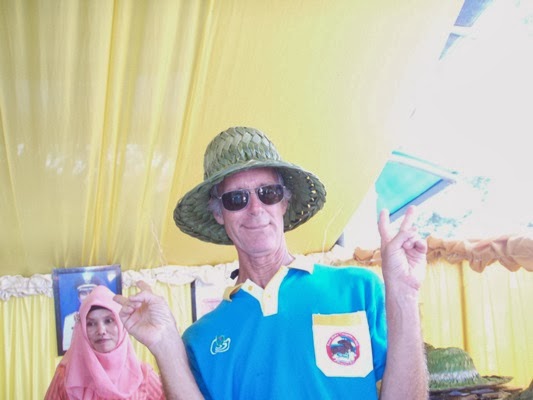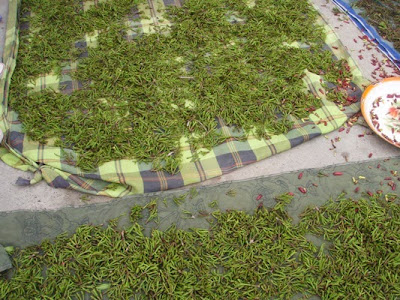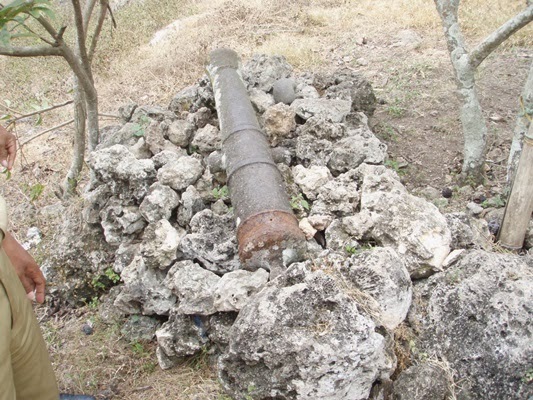We left the tiny island of Sagori and headed to Benteng on the island of Selayer on the southern tip of Sulawesi. Benteng is the regional gov't center for the region that also covers Taka Bonerate, a marine national park. Many of the rally folks are also scuba divers and they were itching to get into clean water to see some of Indonesia's underwater biodiversity, so they headed straight to Taka Bonerate and bypassed the rally stop at the city.
Our rally organizer wasn't happy that folks chose to ignore the local government's offer to host the rally events. We felt that the rally had provided us with so much and the local governments had done so much for us that we really had to go to Benteng and make a showing for the yachts. Only five boats felt that way, though, and the rest chose not to have to sail upwind to get back to Taka Bonerate. I can't blame them, really, as the routing choice to go to Benteng before Taka Bonerate doesn't make sense from a sailing perspective. But the hosts aren't sailors.
Sorry, but these pictures aren't necessarily in order, but it's too tedious to try to move them around with the limited bandwidth available on the internet here. You'll still get the idea, I hope. Some of the photos are from Out of the Blue II with thanks.
Our first sense upon landing on the dock was the smell of drying cloves. Here are some of the tarps laid out with cloves drying on them. Locals would rake them to turn them in the sun and they'd fold up the tarps at night or if it rained.
Our local guides in Benteng. They are all Muslim here. The tiny girl, second from the left, was our favorite. Ain was her name and she was a cheerful, happy guide that always wanted to help and give us as much information as possible. She was a tiny waif of a thing and barely cleared Jason's waist in height.Some of the ladies in the welcome dance in the Plaza Marine, the area where the festivities were held.
It's hard to find bread here in Indonesia, but this green bread was for sale in the plaza. It is made from pandanus, giving it the green color. I wasn't game to buy a loaf to try it though. If it had been St. Patrick's Day, perhaps..... The only other choice is white bread. The loaves are smaller than we are used to and whole meal bread is just not something they do here.
Our first tour took us to the stilt village of Bitombang, where there seems to be an overabundance of elderly villagers, many still working daily. Their homes are perched on stilts--tree trunks that are almost never straight. They are up to 200 years old and the homes are passed down through the generations.
The head of the village and his wife in the stilt village. The lady's hair was down to her calves. Many Indonesian women have very long hair, but you seldom see it as they wear the head scarves almost all the time. That's Chris from Out of the Blue II on the left in his Aussie tour outfit.
Karen at the vice-regent's private villa on the coast outside of town. We were invited to have dinner with his daughter as he was out of town. We got to experience this Cliffside property two days in a row as the official gala dinner was held here, too.
A man keeping the mosque clean.
A 70+-year old woman grinding corn under her home in Bitombang, the stilt village in the mountains.
Karen taking a turn at cranking the old machine.
A nut cracking stone with dimples to hold the nuts. These candle nuts are very hard. They are like macadamia nuts but not quite so flavorful.
Jason trying to crack a nut on the stone, using another stone for a hammer. He got the nut to jump around a bit, but wasn't game to hold it still with his fingers when making the smash with the rock.
Jason and an elder in the stilt village.
This home isn't going to make the next generation. It was falling apart.
Jason walking down to the brick maker area.
Clay bricks stacked to so the air can circulate to dry them. Once they are air-dried, they will be fired and turn orange. There is a lot of sand in these and if they don't have enough clay, they will be light in color and the locals won't want to use them for building as they can disintegrate more easily.
The bricks are used to build the kiln that will fire them. Once these are fired, the kiln will be dismantled and the bricks sold to folks to use for building. Then a new kiln will be built out of the next batch to be fired.
A bright colored beetle crawling on the bricks of the kiln. There was nobody around so we just had a wander and a look around and left again.
These anchors and cannons were from a Chinese ship that was sunk here 4-500 years ago. The Chinese and the Dutch sailors were using Indonesia for the spice trade. This tiny museum in Padang was just this one room with these few pieces in it, next to a primary school/daycare playground.
A tiny wooden replica of the Tana Doang national museum, a different one from where the anchors above are located. We are inside the full sized building, where they opened up the display cases for us to handle the artifacts.
Jason talking to our guide about the wooden Indonesian fishing ship model inside the museum.
Our guide displaying a kris knife from the display case. They still make these crooked knives here in Indonesia, and every man in traditional dress carries a knife in a sheath in his waistband.
Karen holding one of the museum's stone hatchet heads. You can still see the groove where the handle would have been attached.
The guide with one of the spears unsheathed.
From the national museum, we traveled only a few blocks to see the Gong Nekara. aka Don Song Gong. It was originally made in China and brought here by the seafaring traders centuries ago. It was unearthed by a farmer in 1686 and was eventually given to the local government leader as a wedding present. The bronze gong has four bronze frogs on the top of the striking surface. The spots you see on the side are actually square indentations where there were originally diamond and jewels. The frogs' eyes were said to be rubies originally, too, but all the precious stones are now gone. The frogs mean this is a male gong; its female twin is in Viet Nam or China.
The sunburst in the center of the striking surface on the top of the gong. I pounded my fist there and the deep resonating sound was quite satisfying! You can see some of the intricate molding on the surface.
One of the bronze frogs. From the back they looked like a hippo's backside to me.
Our group standing around the gong. Only YOLO and Out of the Blue II were on this tour, so it was basically a private tour with local guides.
The gong from a distance. The sides had relief pictures of elephants, birds, flamingos, palm trees and other animals, but the patina of age makes it hard to see them unless you look closely. They come out best in pencil rubbings but we didn't have paper or pencils with us.
A plaque outside the gong building that tells the story, but the English isn't perfect. One place has the date as 1686, but another place says 1868. Only a couple of hundred years difference....
Jackfruit growing on a tree. Its a big bumpy outside, like a breadfruit, but the inside is a bunch of large, pale yellow teardrop-shaped sections that each have a large seed in them. It has a unique taste that I can't describe, but I wouldn't go out of my way to get it. They sell it in the markets, and on one tour, the village chief cut one and made it available to all of us to try.One of the stilt houses in Bitombang village. They may look rickety, but they are nearly 200 years old, so they must be fairly solid. We had lunch in one of them that wasn't quite as dramatic looking as this one. This one is the highest one in the village, next to the mosque.
Jason showing off his height next to a woman standing on a ledge.
Another view of the house that is falling apart in the stilt village.
Our dinghy tied up to the police launch at the dock in Benteng.
Kids and their instruments in the welcome ceremony. The green and gold cylinders were used in the dance and then given to the audience as gifts. They are made of bamboo with a plastic circle attached to the top that can act as a tiny drum or a lid. The cylinders represented ones originally used to carry food and/or liquids by travelers. We carried ours around on the boat until we reached Belitung, further along in the rally and then gave it away to a little French girl.Our welcome feast was the result of the culinary competition here. Groups of ladies prepared traditional dishes and drinks and once they were judged, we got to choose whatever we wanted to eat.
Another view of a table of food for us to choose from. Often we had no idea what the foods were. Gotta be adventurous eaters to get full here.
Karen trying on the woven palm hats in one of the stands. They gave them away to us, so I took one and used it often as the brim was quite wide and kept more of the sun off.
Jason goofing off with one of the weirder hat designs. The tuft of palm leaves on the top made it look funny and nobody wanted to keep that one.
This is more like it. A useful hat but he rarely wore it in reality.
We went snorkeling out to the reef across the water the next day. The divemasters are the two guys on the left and right. The boat driver and owner is in the middle. They all seem to smoke--that surprised us about the divers, but so many men in Indonesia still smoke.
The "knees" of the outrigger on our snorkel boat. this is the boat that was so loud, we couldn't talk to each other as it was running and it vibrated so much that my eyeballs jiggled in their sockets and I literally couldn't focus on anything until the boat stopped! These wooden branches were tied onto the bamboo outriggers and cross members with twine and allowed a lot of movement as we motored across the water. I'm sure they search hard and long for pieces of wood that bend just at the right places to use for this purpose.
A view from the vice-regent's private Cliffside villa. He is building a tourist lodging facility next to his house to make money in the tourist trade. When you're a top gov't official, you can afford to build such homes on beautiful beachside property.Looking the other direction, you can see part of the beach that rings the shallow bay. We were invited to bring our yachts here and stay a couple of days. Believe me, we thought really hard about doing just that, but in the end we had to get moving on.
Jason with the vice-regent's daughter and her son. She openly admitted that she was divorced, not something we heard often in this Muslim country. She is a Dr. at the local hospital, a dermatologist. Jason and Chris met her at the Regent's home on their tour and she invited us to dinner at their villa that night.
The wooden steps down to the beach. There is a concrete stairway also, but this one is more interesting and adventurous.
Patterns in the sand at low tide as the water runs out.
Our dinner party group. We are at the beach next to the Cliffside home. I didn't bring my bathing suit, but Lyn did and she and Chris got into the water and showered off at the villa afterwards.
Another day, another tour, this time to the Turtle Village. There were giant tubs of the little turtles that had been raised by the villagers and were ready to be set free in the ocean. We paid 25000 rupiahs each to set one free (about $2.50 UDS).
My turtle in a coconut bowl to carry him to the water.
Jason's turtle was a bit rambunctious and tried to climb out of his bowl before even getting near the water.
Karen and her turtle to release. The scarf around my neck was a welcome gift in the ceremony when we arrived.
My baby turtle in the sand, ready to crawl into the surf to go live a life in the ocean.
He's found a friend already.
After a traditional lunch at the Turtle Village, we made our way up to the village of Tentro to view a "dingin dingin" ceremony. That is where bad spirits are invited into a body and then cast back out again. The host body is put into a trance and women dance and carry "dupa" (incense) around and around the body, chanting. The spirits create a cold draft and several folks claimed they felt it. The woman awoke from the trance trembling and in tears. Other women around her were also crying emotionally.
Jason carrying one of the water pots out of the trance house. Women weren't allowed to touch the pots of water after the ceremony and they were one man shy, so asked Jason to carry the pot out.
Once the bad spirits are again out of the body, the villagers sprinkle water on you to bring good spirits back in. The locals here get involved and throw water on the tourists. The kids here are just waiting for the word to get to splashing the visitors and each other.The women make an offering of fruits and veges to the spirits.
The local men are the only ones who can handle the water used in the trance ceremonies. They sprinkle it with palm leaves onto the folks in the crowd.
After all the ceremonies at the different locations in the village, there was a fun bit for the ladies who'd been in the trance. They got to swing in this bamboo swing, held up by some coconut palms tied with twine. Two men used a rope across the stomachs to pull the ladies to get them to swing higher and higher. This was the "attojeng" ceremony, a treat after being put into a trance and having spirits come and go in/out of their bodies. This is a very superstitious village! After the local women, we were given a chance and Lyn and I went for a swing. Our two bule butts barely fit in the swing seat!
Our lunch at the village
We were given the woven rice baskets that we were served with at lunch. A nice souvenir. Note the sealed plastic cups of water; we were given little straws like on a juice box and this was often our only source of drinking water all day. The guides brought cases of these for us to keep hydrated. Such a shame as we saw so many of these plastic cups and straws discarded everywhere. Locals have to buy water to drink, too.
The head of the village showing off a metal mesh helmet, one of the old Chinese artifacts that he keeps at his home.
Chinese antiques that are kept in the village chief's home. They brought them out to show us and we all donated a few rupiah for him to keep maintaining them.
We got talked into staying longer on this island than we'd planned. The local tourism dept rep is taking Jason up the old path to the oldest mosque on the island. It dates back to 700AD and they still follow the original prayer rituals as they did when Islam first came to the island. They haven't changed their religious rituals as most other places have to keep up with the changes in the times.
The first time to the mosque, visitors must touch their heads to the stone a the entrance to the mosque area. We all had to stop and touch our heads to this stone, with the film maker capturing our activities.
Laid out in the square were cloves and this green stuff, which we were told is a form of tobacco. It isn't the large leaves that we think of as tobacco, but a poor man's substitute used here for smoking.
The oldest mosque in Selayar, at Gantarang. We drove across the island through the mountains to get here. The Dutch built a stone causeway through the highlands and then built stone walls all around the village as it was the highest point available. They built gates into the stone walls and outposts, complete with guard seats of stone.
Cameri nuts drying in the sun. These nuts are hard to crack open.
The "footprint of Allah", a dent in the stone about three times the size of the foot here. The other footprint is in Mecca.
Jason at the "window to Mecca". It is said that if you pick up a piece of dirt, pebble, leaf, etc. from here while making a wish, your wish will come true. But first you must walk around the tree and coral scrabble seven times in one direction and three times in the other direction.
Jason going through the southern gate built into the stone wall
One of the locals pushed off the corner of the gate wall and dislodged this stone. Geez, an historic monument and he just pushed the stone off as he was getting up to leave. Glad it wasn't me that did it!Snacks at the village head's house. Fried banana slices with a bowl of sugar to dip them in and some doughnut like fried thing with sprinkles on it. Just about everything in Indonesia is fried!
An old Dutch cannon outside the oldest mosque at Gantarang.
Inside the mosque, the center pole is eaten away to about seven feet off the ground. I was told it was the trunk of a chile tree (I don't think chiles grow on trees so I must've misunderstood) and the attendees of the mosque used to bite off a tiny bit to take the holy place into themselves.
Coming down the modern stairway from the mosque village. Excuse the finger over the top left corner.
This guy is the brother of the head of the village. He had a mischievous look to him all the time and an impish grin. He followed us down out of the village and then played a tune on his flute for us just before we left.On the way back down the mountain, we stopped at a local bathing place in the river. Men come down in the mornings to bathe, and the women come down later to bathe and do the laundry. Note the policeman in the photo. We had police escorts often in these islands and the police actually gave me and Lyn a ride down to a village with bad roads that the tour vans weren't supposed to go on.
Jason mugging it up on YOLO.
Another view of the old Chinese artifacts in Tentro Village.
The forge on the side of the road where these guys are making knives. There is another fellow above them pumping air through huge bamboo bellows to keep the fire hot. They used old suspension springs from cars for their metal and split the metal into knife-sized pieces by banging a blade in the middle until the metal could be broken off and then banged some more to form the desired shape. These guys squatted on their haunches in the sand along the beach in this hut. The guy on the left is holding the metal and the blade; the guy on the right is hammering the blade. Once it breaks, they take turns hammering the knife in rhythm to form it until it cools too much to coninue. Then it goes back into the embers and another piece is pulled out to work on. Every few minutes, the guy on the left scoops more charcoal into the fire. Hot, demanding work for fairly poor quality results. One knife was pulled out of its carved wooden sheath and the wooden handle fell off!
We stopped at a cave that had a river down in it and bats living on the ceiling. It was a steep slope down into the cave. This is just part the way down, looking back up.
You can see that the cave roof just fell in, leaving this hole to the open sky.
Our gala dinner at the Regent's villa included entertainment. These traditional dancers performed for us before sunset and again after dinner. Very pretty in the bright red and gold. The limestone clifftops are part of the villa grounds.
One of the dancers in her finery.
The 'band' that played the music for the dancers to dance to. They had to be uncomfortable sitting on that hard, sharp and hot rocky outcrop, but what a spectacular setting, eh?
The flute player in his traditional dress.
Sunset from the Regent's villa. The dancer is performing a fan dance for us.
Another dancer at the villa.
We're chowing down on the feast they prepared for us at the gala dinner.
After dinner dancing by the pretty young women.
They always want us to join them in the dancing. That's me in the white shirt and skirt, trying to match their movements. Sometimes I think they just like to laugh at us as we try to be graceful and mimic their moves.

































































































No comments:
Post a Comment